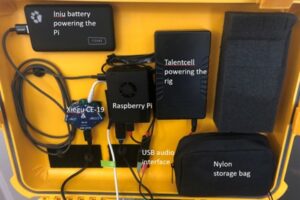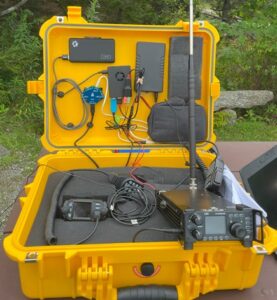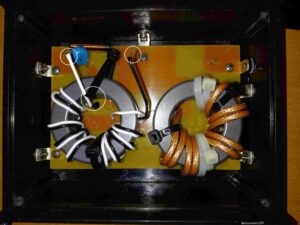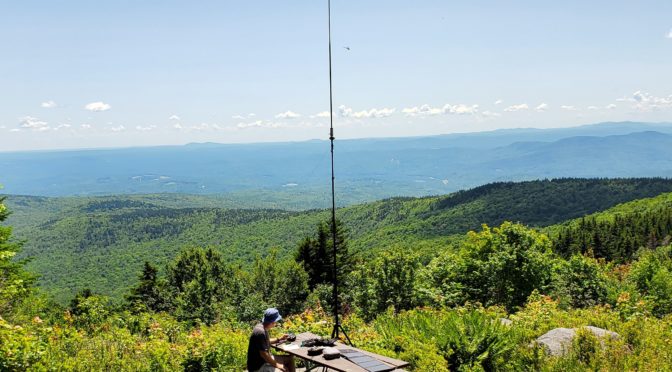Recently, I was asked not only how I made out during the Nashua Area Radio Society’s Sep 3, 2023 Club POTA activation from Rollins State Park (K-2676) and Kearsarge Mountain State Forest (K-4918) (it’s a two-fer), but what the gear was that I used. So I decided to “pen” an article with some of the details.
The Box
Jay Francis, KA1PQK and I decided to put my go-box to the test in the field during this activation. It is an unassuming, little old “shack in a box”… although it is a large box… a large dayglow yellow box. So, maybe it isn’t all that little or unassuming after all. But I digress.

The go-box itself is built around Harbor Freight’s largest protective waterproof ABS case, the Apache 4800. Despite its size, the case lends itself to portability. I literally only need to grab it and my trusty modified Lenovo N23 Chromebook (more on that later) and head out the door. I’ve used this same model Apache case to ship photographic gear all over the country. It works exceptionally well at protecting my gear at roughly 1/2 to 1/3 the cost of a similar Pelican case. I like that, after all, I am a ham.
The go-box contains everything else I will need for an activation in any mode… SSB, CW, or digital. Altogether, the go-box weighs in at around 8 pounds… light enough to easily deploy to most places, but heavy enough that I don’t want to hike with it for a SOTA activation.
The Station
The Radios
The station itself is designed around a Xiegu G90 SDR Transceiver. The G90 is a 20w, all mode, 10-160m SDR radio with some incredible features for such a reasonably priced rig. It has a built-in antenna tuner that will match nearly anything you can throw at it, a (small but useful) waterfall display, DSP noise reduction, etc. The G90 is powered by a Talentcell rechargeable 12V 6000mAh Lithium-ion battery pack. While intended to charge cell phones via it’s 5v USB ports, the Talentcell has a very convenient 12v output port as well, and provides me with up to 2.5 hours of operating at reasonable output power for the radio.
For SSB, I use the stock Xiegu mic that came with the G90. Surprisingly, for a $450 rig, I have received several positive comments on audio quality! For CW, I use a CW Morse paddle. It is small, but hefty enough that it won’t move around the table when I am using it. As the G90 requires additional hardware for digital interfacing, I use a Xiegu CE19 digital interface kit connected to a Raspberry Pi 4b to allow me to operate FT8, RTTY, and other digital modes.
Finally, I have the Xiegu OEM CI-V USB cable that connects the radio to the Pi allowing for rig control and automatic frequency capture in the various software apps that I use. Xiegu radios use the ICOM CI-V protocols for rig control, which makes them (generally) easy to set up and use.
The go-box also contains a QYT dual band mobile FM radio, powered by an external battery. However, we did not use this radio on the activation.
The Antennas
All the RF is forced out of the radio into an MFJ-1899T portable vertical (which also lives in the Apache case when stored). The antenna attaches at the back of the rig to a right-angle connector with a PL259-to-BNC adapter on it. I also have a premeasured and marked counterpoise connected to the G90’s ground point that I deploy to improve the signal.
Jay brought his portable vertical setup as well. It’s an MFJ 2286 portable 7-55MHz antenna on a Husky telescoping tripod. We switched antennas from the 1899T to Jay’s 2286 roughly halfway through the activation. Although I don’t have any empirical data, and my memory is like that of a 130-year-old, I recall that Jay’s vertical worked quite a bit better. No surprise, given that the 1899T is a true compromise antenna. But it does make Q’s.

The Computer
The Pi is powered separately from the radio’s power source by an Iniu 10,000 mAh 5v battery and can run for 6 or so hours on a single charge. As the Pi’s integrated audio hardware is insufficient for use with digital modes, I use an inexpensive Sabrent USB audio dongle which works nicely. For time synchronization, I either manually update the time on the Pi (as was the case on this POTA activation) or use a U-Blox USB GPS dongle connected to the Pi for a GPS time source. I did bring a new solar charger setup with me on this activation, but never deployed it.
The Software
The software on the Pi is a critical part of the entire solution, without which, the whole “shack in a box” concept goes out the window (ask me how I know this). At the base is the Raspberry Pi O/S, which I built from KM4ACK’s awesome Build-a-Pi solution. Although BAP is being replaced by 73 Linux, it is still an excellent quick deployment solution for a Raspberry Pi. The Pi contains a host of software applications that you would find in any shack, as well as some that are specifically EMCOMM related, and some that facilitate portable operation. I’ll go through what we used during the activation and leave the other details for a future article perhaps.
The Pi also has a hot-spot solution that auto starts when no known network is detected. The hot-spot is the real key to the overall shack-in a box solution though… but more on that later. For rig control, FLRig is my go to – it allows FLDigi, WSJT, and my logging program, CQR Log, to have connectivity to the radio. When operating SSB or CW, I simply fire up CQR Log and it starts FLRig, which connects to the radio, and I am off to the races. If I am instead operating digital using WSJT or FLDigi, I need only to tell CQR Log to start either program, and it seamlessly connects and shares QSO data (I say seamlessly now, not so much until I truly figured out how to integrate the software pieces… but that’s for another article too).

The “Other” Computer
Truly attentive readers may have noticed something missing though… a screen with which to view the Pi desktop. That’s kind of important. This is where the hot-spot feature of the Pi is really handy. It’s also where my Lenovo Chromebook comes into play. Although in reality, the Lenovo is no longer a Chromebook per se, but more of a “Linuxbook”. I removed Chrome from it and installed Debian Linux instead. There are videos on YouTube as to how to do this. It’s a great way to “rehab” an outdated Chromebook that cost $7 on eBay, and Linux is a great choice for portable ops as it is so much more flexible than Windows (in my opinion). I use the Linuxbook to VNC into the Pi and view the desktop. It is a slick solution that I admittedly copied from others. Any device with a VNC software app can be used, provided it can connect to the Pi’s hot-spot network (you do however need to know the password to the hot spot, which I now have written down). This includes Windows systems, iOS devices, Linux devices, Android devices, etc. In a real EMCOMM situation, that level of flexibility is nice.
The decision to include a Pi in the go-box was a simple one for me… having a preconfigured hardware / software solution with all of my apps in a single self-supporting enclosure requiring only a VNC capable device to operate it seemed like a pretty cool idea. So far, barring some experimentation and poor decision making by yours truly, it has proven mostly reliable.
Results
So, how did it do during the activation? We made 23 QSO’s running anywhere from 5 to 20 watts: 21 FT8, and 2 SSB. We contacted hunters all over the country… TX, OK, MS, NC, SC, IL, NH, GA, and even a DX station in England. Several park-goers stopped and talked to us about what we were doing, and we got to explain Ham Radio and POTA to a number of them. While it certainly proved a useable solution for the activation, I am constantly looking at ways to refine it and make it better and more “bullet proof”.

Here are some links to the various components of the go-box in case you are interested in more details:
Apache 4800 case: https://www.harborfreight.com/4800-weatherproof-protective-case-x-large-yellow-56865.html
Xiegu G-90: https://www.hamradio.com/detail.cfm?pid=H0-016772
Raspberry Pi 4b: https://www.raspberrypi.com/products/raspberry-pi-4-desktop-kit/
Sabrent USB Audio: https://www.amazon.com/gp/product/B00IRVQ0F8/ref=ppx_yo_dt_b_search_asin_title?ie=UTF8&psc=1
KM4ACK Build-a-Pi: https://github.com/km4ack
WSJT: https://wsjt.sourceforge.io/wsjtx.html
FLDigi: http://www.w1hkj.com/
CQR Log: https://www.cqrlog.com/
U-Blox GPS: https://www.amazon.com/gp/product/B00NWEEWW8/ref=ppx_yo_dt_b_search_asin_title?ie=UTF8&psc=1
MFJ 1899T Antenna: https://mfjenterprises.com/products/mfj-1899t
MFJ 2286 Antenna: https://mfjenterprises.com/products/mfj-2286
Husky K40366 Tripod: https://www.homedepot.com/p/Husky-Universal-Telescoping-Tripod-K40366/319012088
Iniu Battery https://www.amazon.com/gp/product/B08MBQS368/ref=ppx_yo_dt_b_search_asin_title?ie=UTF8&th=1
Talentcell Battery: https://www.amazon.com/gp/product/B00ME3ZH7C/ref=ppx_yo_dt_b_search_asin_title?ie=UTF8&psc=1
Apache case ID tag: https://www.hamcrazy.com/index.php?main_page=index&cPath=44
If you decide to build your own go-box, have fun, get creative, and post some pics on the N1FD.org site!





